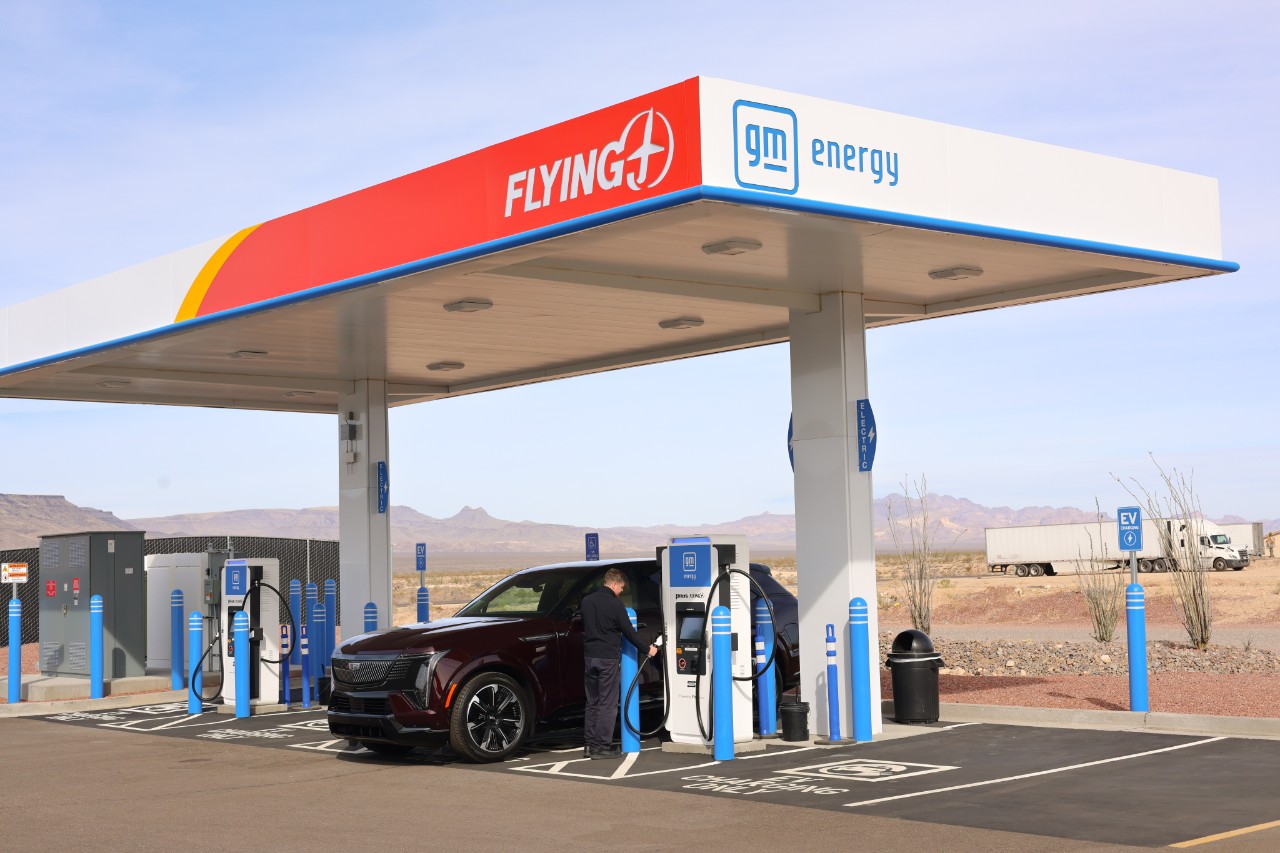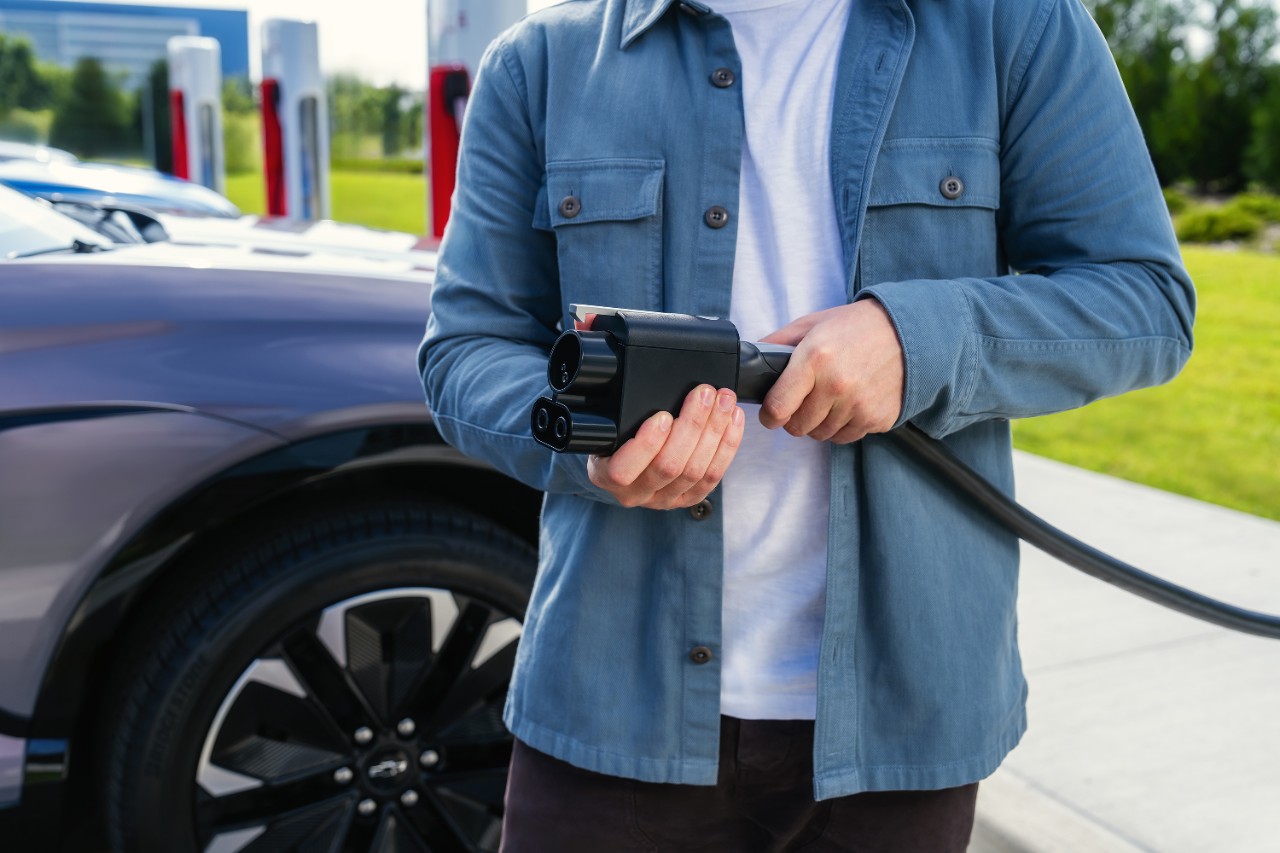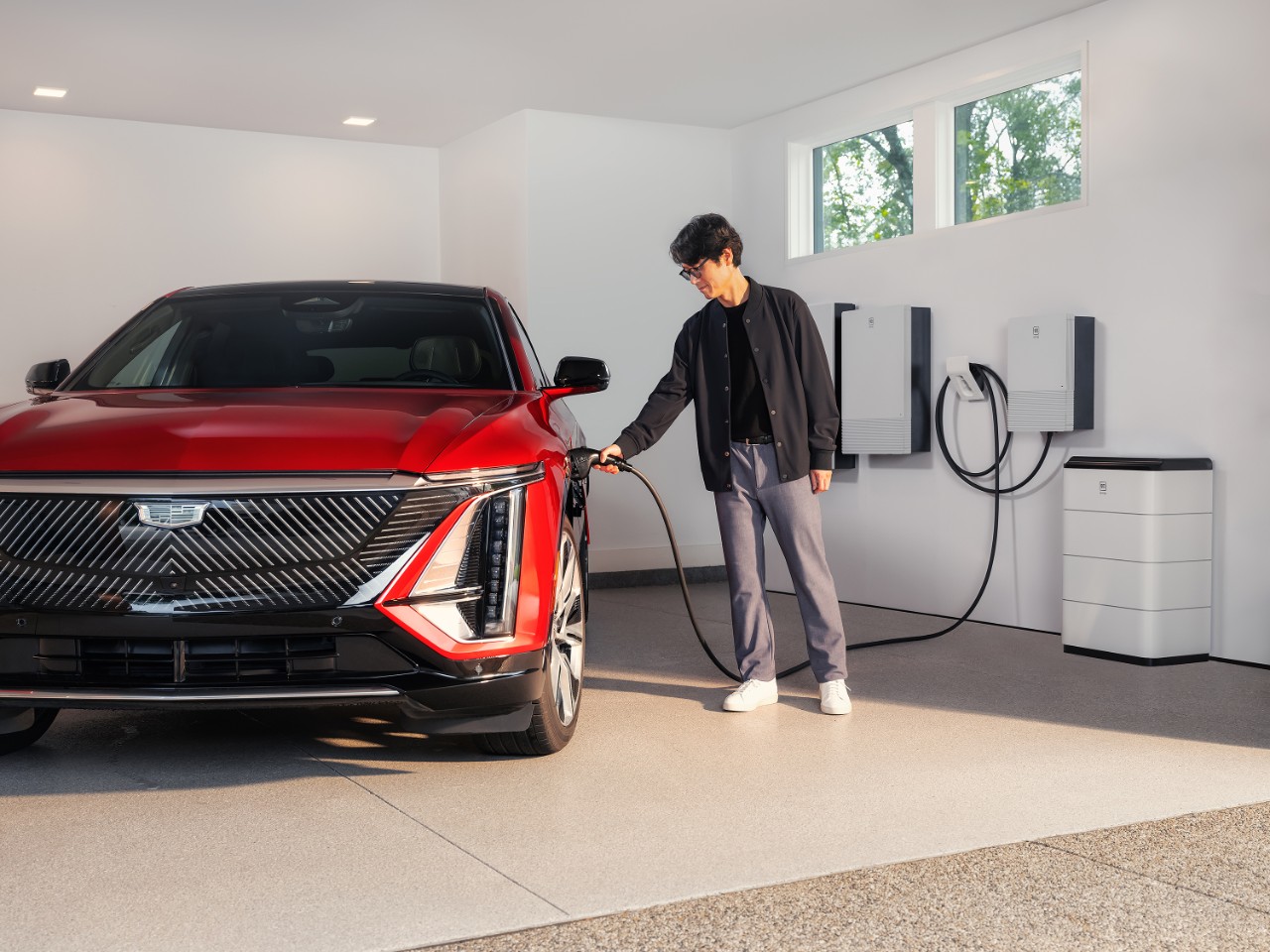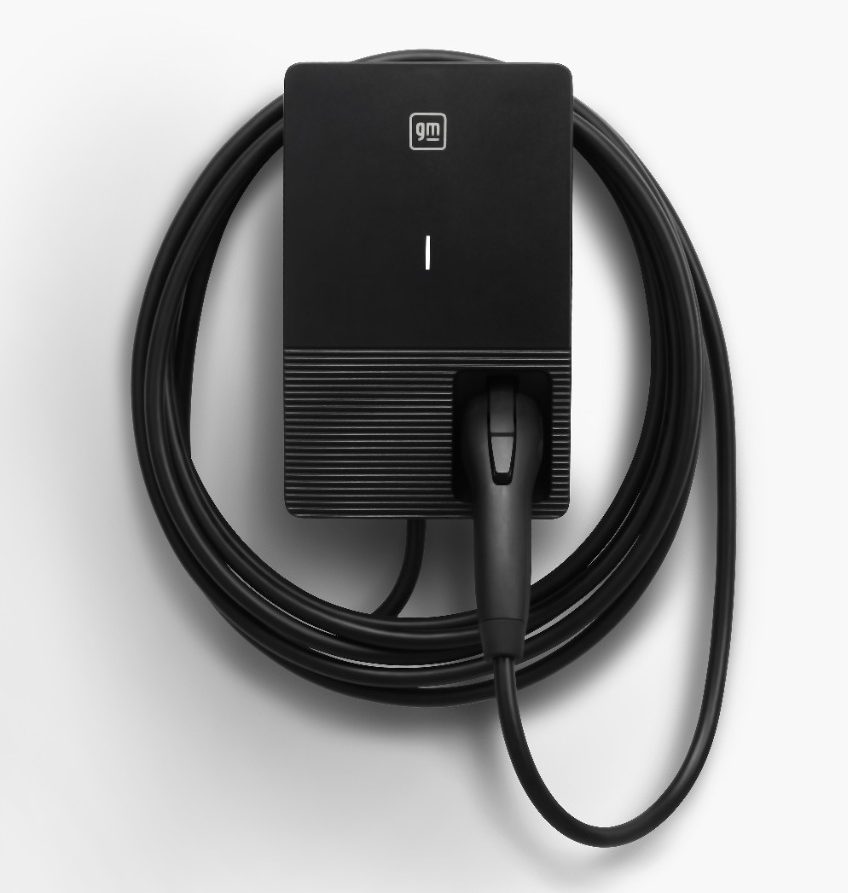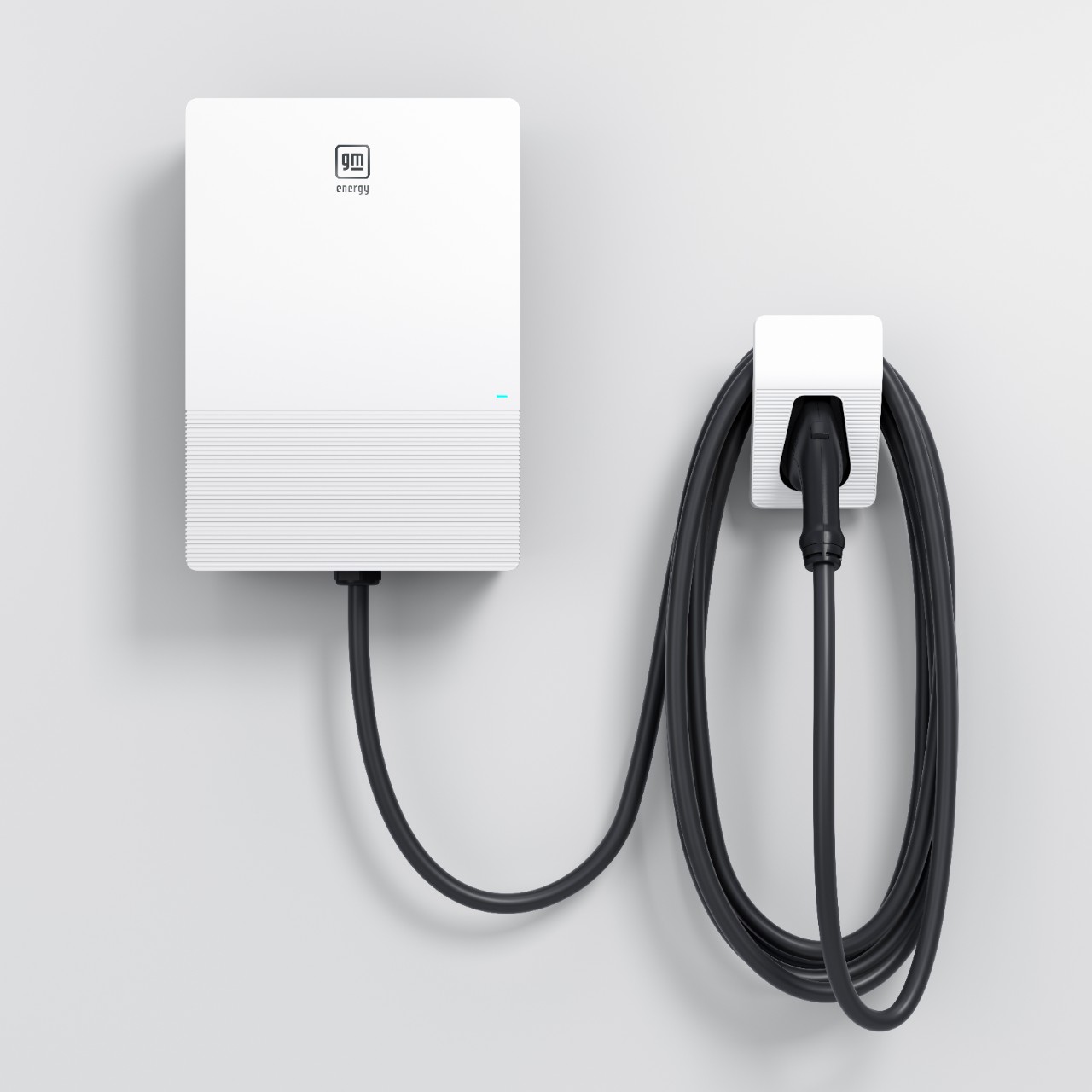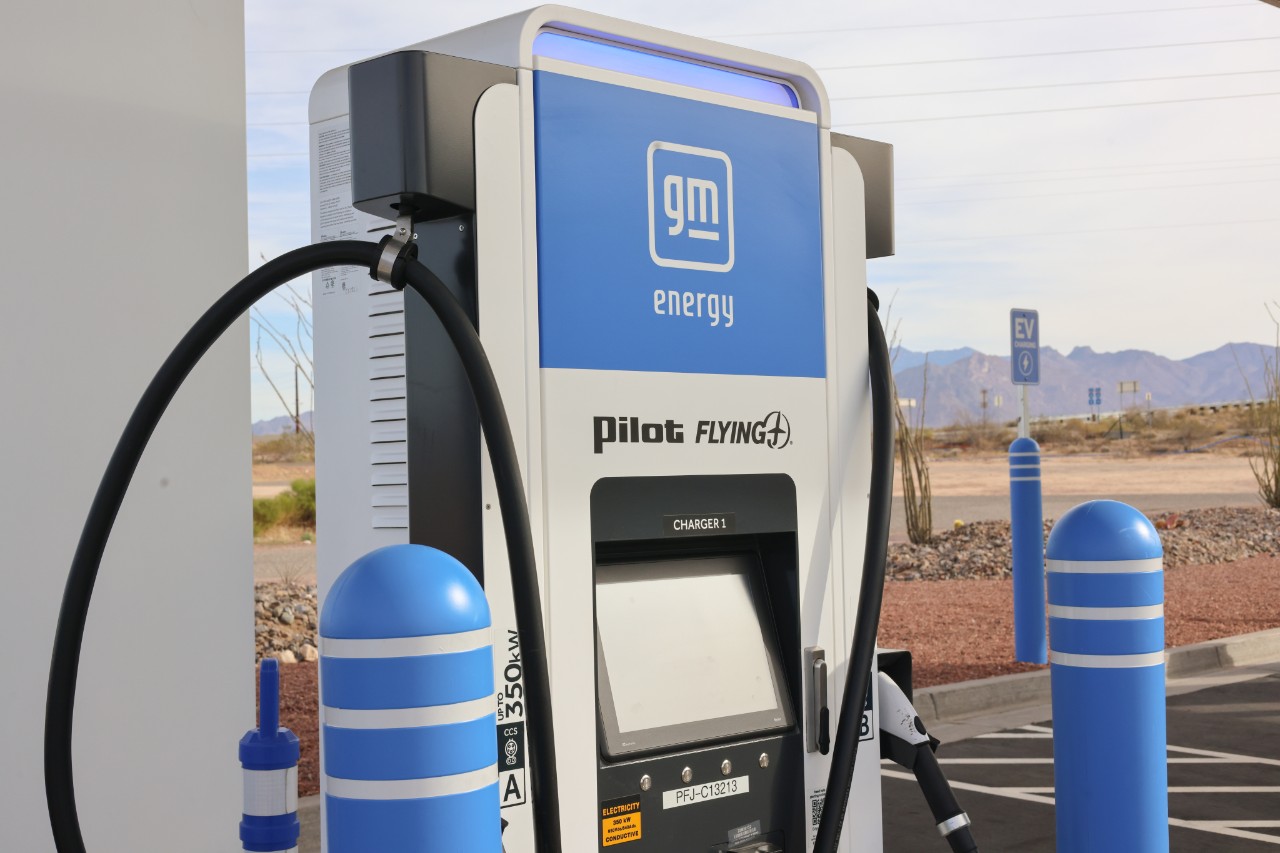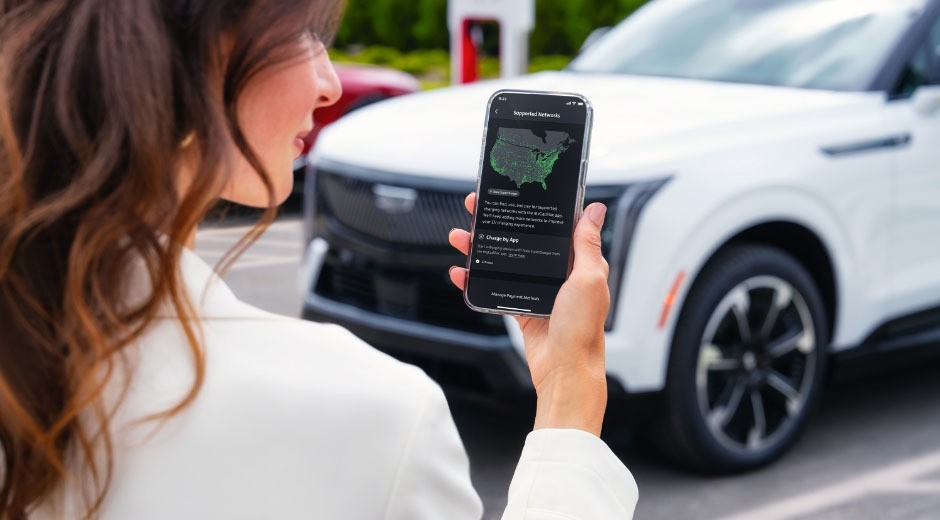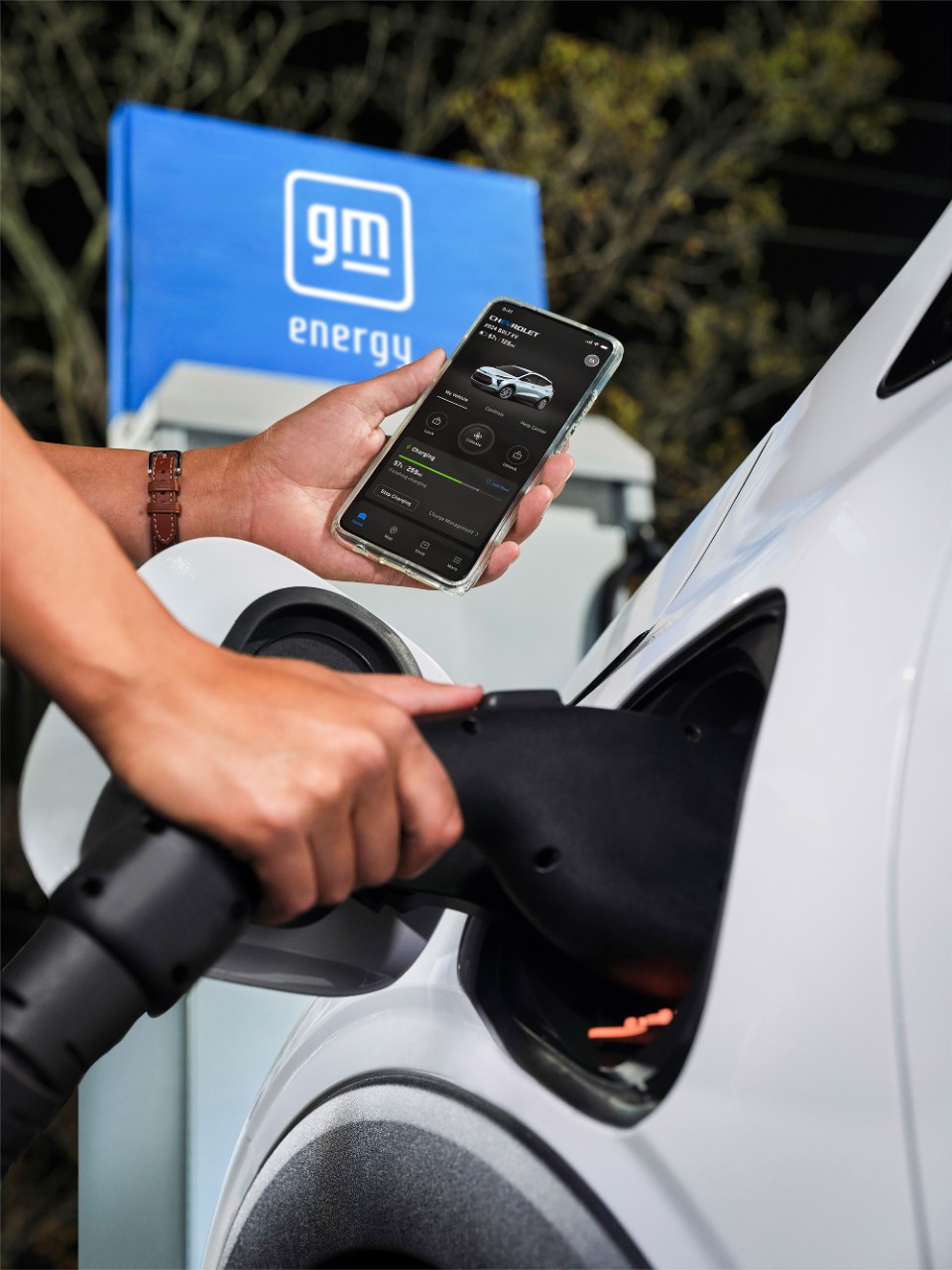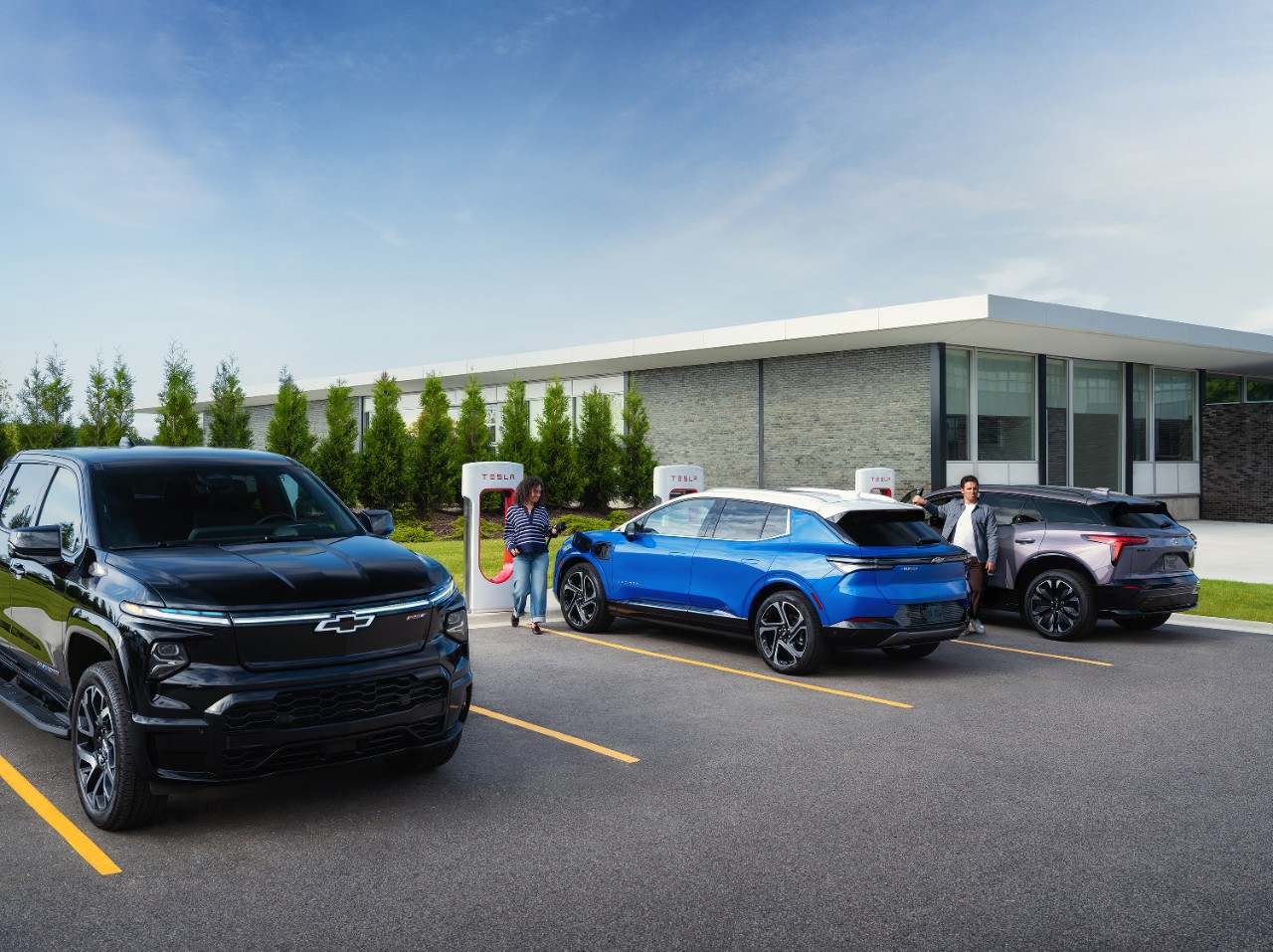EV charging 101: A primer on staying juiced, at home or on the road
2025-07-11
Getting started with a General Motors electric vehicle? Keeping your car charged is simpler than you might think.
Let’s dive into the basics of how to juice up – whether at home or on the road.
Let’s talk plugs
Before you can plug in, it’s important to know what kind of charging port your GM EV has. That’s because there are two primary types of EV charging plugs in the U.S.
Think of it like the outlets in your home — some have two prongs; others have three. The shape has to match the socket. EVs work the same way. The charger plug must match the port on your vehicle.
Caption: A NACS charging cable
Today, most GM EVs — and many from other automakers — come equipped with a CCS inlet. If you’re driving a GM EV right now, chances are it has a combined CCS/J1772 port.
But change is coming. In 2023, GM announced its intention to transition from CCS to NACS beginning in 2025. And we recently announced the 2026 Cadillac OPTIQ and OPTIQ-V will be the first GM EVs confirmed to come equipped with a native NACS charging inlet, capable of both DC fast charging and slower home charging. This transition to NACS helps drive the industry toward a single, simple standard, and gives customers direct access to a broad network of charging options.
As GM EVs make the transition to NACS, GM Energy is committed to helping customers navigate it with confidence. Later this year, we’ll introduce adapters that enable GM EV owners to charge where and when they need to, regardless of the type of charger.
For this guide, we are going to focus on the combined CCS/J1772, which is the port that the majority of our current EVs are equipped with today.
Let’s dive in.
Home charging
Caption: Many EV drivers prefer the convenience of charging in their own garage.
Now that we know about the types of charger plugs – again you have a CCS port in your GM EV – let's talk about the most convenient way to charge your EV. Many EV owners charge their EV at home – and some never charge anywhere else. And for good reason. Home charging can be the most cost-effective way to keep your EV powered up, in addition to being the most convenient way.
Let’s review.
There are two primary levels of home charging.
Level 1 (standard 120-Volt outlet): The simplest option is to use a basic portable charging cable that plugs into a standard power outlet on one end and into your car’s charging port on the other. Commonly referred to as “trickle charging,” this is a slow and steady option, adding up to 3 to 5 miles of range per hour1, depending on your vehicle and other conditions. If you have a short commute to work, an overnight charge of sufficient duration could give you enough range to get to work and back. One of the best things about trickle chargers is that they don’t require any other special equipment – you can typically plug them into normal electrical sockets almost anyplace.
Level 2 (240-Volt): Level 2 charging allows you to charge faster than a standard outlet can allow – up to 7 to 40 miles of range per hour1,2 depending on multiple factors, including the charger, the weather and the vehicle.
GM offers a 240-volt adapter that swaps out with the 120-volt plug in a standard charging cable – that could be your method of charging the day you drive home from the dealership if you have the required 240-volt outlet already installed. It should be considerably faster than charging through a 120-volt outlet.
But to juice up faster, you’ll want to consider a built-in home charger.
GM Energy offers EV buyers multiple home charging equipment options:
The GM PowerUp 2 charger is a great solution for customers who want simple and efficient overnight charging. 2023 Chevrolet Silverado EV RST Edition 1 customers, for example, can add about 19 miles of range per hour with this charger.1,2
Caption: The GM PowerUp 2 charger
The GM Energy PowerShift charger can add about 32 miles of range per hour to the same model 2023 Chevrolet Silverado EV and has bidirectional charging capabilities.1,2 When installed with the GM Energy V2H Enablement Kit, the GM Energy PowerShift charger can transform your compatible GM EV into a backup power source for your properly equipped home during a power outage.3
Caption: The GM Energy PowerShift charger
Charger installation
Once the GM Energy consultants have helped you select the home charger that best meets your needs, you’ll need to think about installation; our technical advisors can provide advice to qualified professionals on installation and troubleshooting. GM Energy also connects its customers with preferred installation providers like Qmerit to help ensure a seamless setup.
Working with your power provider
GM Energy collaborates with leading utility companies like Pacific Gas & Electric in California to help make home charging more cost-effective and energy efficient. GM and PG&E have launched a pilot program that integrates Vehicle-to-Home technology, allowing EVs to serve as backup power while also helping to stabilize the grid in the future during peak demand.4
Similarly, our “Free Charge Nights” initiative with Reliant, an NRG company, in Texas aims to expand managed charging programs, where EV owners can benefit from reduced electricity rates when charging during off-peak hours.
Public charging
Caption: A close up of an GM Energy/Flying J/Pilot charging station.
GM customers have access to more than 250,000 chargers across North America. That includes GM Energy branded chargers that are part of our collaborations with industry leaders including EVgo, Pilot and ChargePoint. GM customers can also charge at the new IONNA Rechargery locations, which are being developed as part of a joint venture founded by GM and other automakers.
Caption: GM EV drivers can use an app to find convenient charging stations.
In these collaborations, we’re focusing on not only expanding the number of public chargers available for our customers but also improving the reliability and overall experience with amenities like restrooms, food, retail options and more.
GM customers also have access to more than 21,500 Tesla Superchargers, with the use of a GM-approved NACS charging adapter.
Public charging options
Level 2 public chargers: Imagine you’re at the mall. You park your car and plug in, and by the time you’re done, you’ve added a solid chunk of range, which will vary by charger and vehicle. You can find these chargers in select parking garages, shopping centers and cinema parking lots, hotels and other locations where you’d plan to spend a few hours.
DC fast public chargers: DC fast chargers are more powerful than Level 2 chargers, with the ability to add range much more quickly – some chargers can fully power your EV in as little as 15-30 minutes. (The exact speed will vary by both charger and vehicle.)1 There are a growing number of DC fast chargers on major interstates and highways, like through our collaboration with Pilot and EVgo, helping make long-distance EV road trips convenient.
Finding charging stations
New GM EVs have built-in Google Maps and a route planning tool to help take the guesswork out of trip planning.
Simply input your destination and the system will recommend charging options along your route, with filters including charging speed and other helpful information. When route planning, you’ll want to keep a close watch on specific charger types offered at the location you’re going, whether they’re actually available, and what amenities might be nearby.
There are also multiple mobile apps that can help you find charging stations, including the GM vehicle brand apps, which customers can use to help find chargers along their route.
Plugging in at a public charger
You’ve made it to your charging station, pulled into an open spot and parked... now what?
Step 1: Safety first. Always be aware of your surroundings before exiting your vehicle.
Step 2: Get out and open your charging port door. If you are at a DC fast charger, pull out the small cap covering the lower portion of the port.
Step 3: Plug in. You’ll feel the plug click into the port, so you know it’s secure.
A light ring around the charging port flashes blue to indicate the vehicle recognizes a charger has been plugged in. It turns green when charging starts and remains green throughout the session. If it turns red, that signals a problem—check the app or station for more information.
To charge at a Supercharger on the Tesla Supercharger Network, you’ll need a GM-approved NACS DC adapter, which can be ordered via your GM vehicle brand app or at your local dealership.
Paying for charging
Now that your EV is plugged into the charger, the next step is payment.
Today, how you pay for public charging depends on the network you’re using. For new EV owners, this can be the most confusing part of the public charging experience. But after a little prep work, it becomes easy and convenient.
The first option is to charge as a guest. Many stations allow you to start a session by simply swiping a debit or credit card — similar to how you pay at a gas pump.
Most networks, however, encourage you to download their app, create a customer profile, and add your payment information. Once your account is set up, you can initiate charging sessions directly from your phone and track charging progress in real time.
GM is simplifying this process for its customers. Thanks to GM Energy’s collaborations with companies like EVgo, Pilot, IONNA and ChargePoint, GM customers can link their accounts directly within the mobile GM vehicle brand app—giving you one app, one login, and one place to manage your public charging experience.
Caption: Drivers can pay for their charging sessions right on their phones.
The magic of plug and charge
Plug and Charge is a feature available through the mobile GM vehicle brand app.
With Plug and Charge, there’s no need to open an app, tap a card, or confirm payment. Once your vehicle is enrolled within your mobile vehicle app and your account is linked with participating charging networks, all you have to do is plug in and walk away.
Your vehicle securely identifies itself to the charger, verifies your account, and automatically begins the charging session and payment — no extra steps required.
It’s as seamless as charging gets, and it’s already live at many stations across North America. As more charging networks adopt Plug and Charge capabilities, GM customers can look forward to an even more effortless and reliable public charging experience—powered by technology that works quietly in the background.
Finished charging?
When the vehicle has reached your desired charge level, it will stop charging and the plug will be unlocked. You can also manually stop charging using the controls at the charging station or by tapping “Stop” on the Charging page on your vehicle’s center display.
If you’re using DC fast charging, many providers allow users to stop charging via the station’s app on your smartphone.
To complete the charging process in a GM EV:
Unplug the charge cord from the vehicle.
Close the charge port door. (If you leave your charge port door open and open the driver door, you’ll hear three beeps to remind you to close it.)
About charging speeds
Not all public chargers deliver power at the same speed. The rate depends on the vehicle, the charger, battery temperature, battery conditioning, ambient temperature inside and outside the vehicle, battery current and voltage, remaining battery life, battery state of health, and driver inputs such as recent driving behaviors and conditions.
To provide optimal charging rates and to maximize performance and battery life, the rate of charging will start slowing down as your battery fills up, with a significant reduction in charge rate of around 80%.
Pre-conditioning your battery and charging to 80% for daily use helps promote battery health and can allow you to gain optimal benefits from regenerative braking.
For longer trips, you can adjust your charge above 80% for extended range.
Public charging etiquette
Caption: Make sure to leave the appropriate space for neighboring cars at public stations.
There are some basic rules to follow to play nicely with other EV drivers.
It’s typically best to unplug from a DC fast charger at 80% given the slow rate of charge from that point to 100%. If you need to charge to fully capacity, try to switch to an L2 charger to top up.
Don’t pull into a charging spot if you’re not actively charging – and move your car when your charge is complete.
Remember that many chargers share power, which means a charger with two plugs rated for 350kW may only distribute half that power to each EV charging. It is a nice common courtesy to choose a parking stall on a separate charger from your neighbor whenever possible. But don’t worry if it’s not possible — 175kW is plenty of power for many EVs.
Don’t unplug someone else’s car.
Return the connector back to the charger when your charge is complete.
Stay calm and power on
Whether at home or on the go, keeping an EV charged is easier than ever, with convenient home charging options from GM Energy and an expanding network of public charging options.
Just plug in, charge up, and drive. GM has your EV charging covered.
1Actual charge times will vary based on battery condition, output of charger, vehicle settings and battery temperature. See the Owner’s Manuals for your vehicle and charger for additional details and limitations.
2Requires professional installation of a compatible wall charger, sold separately. Actual charge times will vary based on battery condition, output of charger, vehicle settings and battery temperature. See the Owner’s Manuals for your vehicle and charger for additional details and limitations.
3Actual production will vary. The GM Energy PowerShift Charger and GM Energy V2H Enablement Kit shown requires an adequately charged V2H-capable GM EV, a properly equipped home, and proper grid interconnection. Weather conditions, life of the battery, vehicle variation and usage, and other external factors may impact the capability and duration of power supply. Power supply may be interrupted. It is not recommended that the following devices be powered with the GM Energy PowerShift Charger and V2H Enablement Kit: Medical Devices.
V2H-capable GM EV’s: 24MY Silverado EV, 24MY Sierra EV, 24MY Chevrolet Blazer EV, 24MY Chevrolet Equinox EV, 24MY Cadillac LYRIQ, 25MY Silverado EV, 25MY Sierra EV, 25MY Chevrolet Blazer EV, 25MY Chevrolet Equinox EV, 25MY Cadillac LYRIQ, 25MY Cadillac OPTIQ, 25MY Cadillac Escalade IQ (anticipated 26MY VISTIQ, 26MY LYRIQ, 26MY LYRIQ-V, 26MY ESCALADE IQ/IQL). Some eligible 24MY EVs will require a dealership or over-the- air update to enable V2H capability.
4To learn more about the program or how to enroll, please visit GM Energy Enrollment Portal.
A GM Energy/Flying J charging station.
Getting started with a General Motors electric vehicle? Keeping your car charged is simpler than you might think.
Let’s dive into the basics of how to juice up – whether at home or on the road.
Let’s talk plugs
Before you can plug in, it’s important to know what kind of charging port your GM EV has. That’s because there are two primary types of EV charging plugs in the U.S.
- CCS (Combined Charging System)
- NACS (North American Charging Standard)
Think of it like the outlets in your home — some have two prongs; others have three. The shape has to match the socket. EVs work the same way. The charger plug must match the port on your vehicle.
With a NACS adapter, you can charge GM EVs at Tesla Superchargers.
Today, most GM EVs — and many from other automakers — come equipped with a CCS inlet. If you’re driving a GM EV right now, chances are it has a combined CCS/J1772 port.
But change is coming. In 2023, GM announced its intention to transition from CCS to NACS beginning in 2025. And we recently announced the 2026 Cadillac OPTIQ and OPTIQ-V will be the first GM EVs confirmed to come equipped with a native NACS charging inlet, capable of both DC fast charging and slower home charging. This transition to NACS helps drive the industry toward a single, simple standard, and gives customers direct access to a broad network of charging options.
As GM EVs make the transition to NACS, GM Energy is committed to helping customers navigate it with confidence. Later this year, we’ll introduce adapters that enable GM EV owners to charge where and when they need to, regardless of the type of charger.
For this guide, we are going to focus on the combined CCS/J1772, which is the port that the majority of our current EVs are equipped with today.
Let’s dive in.
Home charging
Plugging in at home is easy with a GM Energy charging system.
Now that we know about the types of charger plugs – again you have a CCS/J1772 port in your GM EV – let's talk about the most convenient way to charge your EV. Many EV owners charge their EV at home – and some never charge anywhere else. And for good reason. Home charging can be the most cost-effective way to keep your EV powered up, in addition to being the most convenient way.
Let’s review.
There are two primary levels of home charging.
- Level 1 (standard 120-Volt outlet): The simplest option is to use a basic portable charging cable that plugs into a standard power outlet on one end and into your car’s charging port on the other. Commonly referred to as “trickle charging,” this is a slow and steady option, adding up to 3 to 5 miles of range per hour1, depending on your vehicle and other conditions. If you have a short commute to work, an overnight charge of sufficient duration could give you enough range to get to work and back. One of the best things about trickle chargers is that they don’t require any other special equipment – you can typically plug them into normal electrical sockets almost anyplace.
- Level 2 (240-Volt): Level 2 charging allows you to charge faster than a standard outlet can allow – up to 7 to 40 miles of range per hour1,2 depending on multiple factors, including the charger, the weather and the vehicle.
GM offers a 240-volt adapter that swaps out with the 120-volt plug in a standard charging cable – that could be your method of charging the day you drive home from the dealership if you have the required 240-volt outlet already installed. It should be considerably faster than charging through a 120-volt outlet.
But to juice up faster, you’ll want to consider a built-in home charger.
GM Energy offers EV buyers multiple home charging equipment options:
- The GM PowerUp 2 charger is a great solution for customers who want simple and efficient overnight charging. 2024 Chevrolet Silverado EV RST First Edition customers, for example, can add about 19 miles of range per hour with this charger.1,2
A GM Energy PowerUp charger
- The GM Energy PowerShift charger can add about 32 miles of range per hour to the same model 2023 Chevrolet Silverado EV and has bidirectional charging capabilities.1,2 When installed with the GM Energy V2H Enablement Kit, the GM Energy PowerShift charger can transform your compatible GM EV into a backup power source for your properly equipped home during a power outage.3
The GM Energy PowerShift charger
Charger installation
Once the GM Energy consultants have helped you select the home charger that best meets your needs, you’ll need to think about installation; our technical advisors can provide advice to qualified professionals on installation and troubleshooting. GM Energy also connects its customers with preferred installation providers like Qmerit to help ensure a seamless setup.
Working with your power provider
GM Energy collaborates with leading utility companies like Pacific Gas & Electric in California to help make home charging more cost-effective and energy efficient. GM and PG&E have launched a pilot program that integrates Vehicle-to-Home technology, allowing EVs to serve as backup power while also helping to stabilize the grid in the future during peak demand.4
Similarly, our “Free Charge Nights” initiative with Reliant, an NRG company, in Texas aims to expand managed charging programs, where EV owners can benefit from reduced electricity rates when charging during off-peak hours.
Public charging
Close up of a GM/Pilot/Flying J charging station
GM customers have access to more than 250,000 chargers across North America. That includes GM Energy branded chargers that are part of our collaborations with industry leaders including EVgo, Pilot and ChargePoint. GM customers can also charge at the new IONNA Rechargery locations, which are being developed as part of a joint venture founded by GM and other automakers.
Your GM vehicle app can help you find public chargers.
In these collaborations, we’re focusing on not only expanding the number of public chargers available for our customers but also improving the reliability and overall experience with amenities like restrooms, food, retail options and more.
GM customers also have access to more than 21,500 Tesla Superchargers, with the use of a GM-approved NACS charging adapter.
Public charging options
- Level 2 public chargers: Imagine you’re at the mall. You park your car and plug in, and by the time you’re done, you’ve added a solid chunk of range, which will vary by charger and vehicle. You can find these chargers in select parking garages, shopping centers and cinema parking lots, hotels and other locations where you’d plan to spend a few hours.
- DC fast public chargers: DC fast chargers are more powerful than Level 2 chargers, with the ability to add range much more quickly – some chargers can fully power your EV in as little as 15-30 minutes. (The exact speed will vary by both charger and vehicle.)1 There are a growing number of DC fast chargers on major interstates and highways, like through our collaboration with Pilot and EVgo, helping make long-distance EV road trips convenient.
Finding charging stations
New GM EVs have built-in Google Maps and a route planning tool to help take the guesswork out of trip planning.
Simply input your destination and the system will recommend charging options along your route, with filters including charging speed and other helpful information. When route planning, you’ll want to keep a close watch on specific charger types offered at the location you’re going, whether they’re actually available, and what amenities might be nearby.
There are also multiple mobile apps that can help you find charging stations, including the GM vehicle brand apps, which customers can use to help find chargers along their route.
Plugging in at a public charger
You’ve made it to your charging station, pulled into an open spot and parked... now what?
- Step 1: Safety first. Always be aware of your surroundings before exiting your vehicle.
- Step 2: Get out and open your charging port door. If you are at a DC fast charger, pull out the small cap covering the lower portion of the port.
- Step 3: Plug in. You’ll feel the plug click into the port, so you know it’s secure.
A light ring around the charging port flashes blue to indicate the vehicle recognizes a charger has been plugged in. It turns green when charging starts and remains green throughout the session. If it turns red, that signals a problem—check the app or station for more information.
To charge at a Supercharger on the Tesla Supercharger Network, you’ll need a GM-approved NACS DC adapter, which can be ordered via your GM vehicle brand app or at your local dealership.
Paying for charging
Now that your EV is plugged into the charger, the next step is payment.
Today, how you pay for public charging depends on the network you’re using. For new EV owners, this can be the most confusing part of the public charging experience. But after a little prep work, it becomes easy and convenient.
The first option is to charge as a guest. Many stations allow you to start a session by simply swiping a debit or credit card — similar to how you pay at a gas pump.
Most networks, however, encourage you to download their app, create a customer profile, and add your payment information. Once your account is set up, you can initiate charging sessions directly from your phone and track charging progress in real time.
GM is simplifying this process for its customers. Thanks to GM Energy’s collaborations with companies like EVgo, Pilot, IONNA and ChargePoint, GM customers can link their accounts directly within the mobile GM vehicle brand app—giving you one app, one login, and one place to manage your public charging experience.
You can use your GM app to manage your public charging sessions.
The magic of plug and charge
Plug and Charge is a feature available through the mobile GM vehicle brand app.
With Plug and Charge, there’s no need to open an app, tap a card, or confirm payment. Once your vehicle is enrolled within your mobile vehicle app and your account is linked with participating charging networks, all you have to do is plug in and walk away.
Your vehicle securely identifies itself to the charger, verifies your account, and automatically begins the charging session and payment — no extra steps required.
It’s as seamless as charging gets, and it’s already live at many stations across North America. As more charging networks adopt Plug and Charge capabilities, GM customers can look forward to an even more effortless and reliable public charging experience—powered by technology that works quietly in the background.
Finished charging?
When the vehicle has reached your desired charge level, it will stop charging and the plug will be unlocked. You can also manually stop charging using the controls at the charging station or by tapping “Stop” on the Charging page on your vehicle’s center display.
If you’re using DC fast charging, many providers allow users to stop charging via the station’s app on your smartphone.
To complete the charging process in a GM EV:
- Unplug the charge cord from the vehicle.
- Close the charge port door. (If you leave your charge port door open and open the driver door, you’ll hear three beeps to remind you to close it.)
About charging speeds
Not all public chargers deliver power at the same speed. The rate depends on the vehicle, the charger, battery temperature, battery conditioning, ambient temperature inside and outside the vehicle, battery current and voltage, remaining battery life, battery state of health, and driver inputs such as recent driving behaviors and conditions.
To provide optimal charging rates and to maximize performance and battery life, the rate of charging will start slowing down as your battery fills up, with a significant reduction in charge rate of around 80%.
Pre-conditioning your battery and charging to 80% for daily use helps promote battery health and can allow you to gain optimal benefits from regenerative braking.
For longer trips, you can adjust your charge above 80% for extended range.
Public charging etiquette
Using a NACS plug at a public charging station
There are some basic rules to follow to play nicely with other EV drivers.
- It’s typically best to unplug from a DC fast charger at 80% given the slow rate of charge from that point to 100%. If you need to charge to fully capacity, try to switch to an L2 charger to top up.
- Don’t pull into a charging spot if you’re not actively charging – and move your car when your charge is complete.
- Remember that many chargers share power, which means a charger with two plugs rated for 350kW may only distribute half that power to each EV charging. It is a nice common courtesy to choose a parking stall on a separate charger from your neighbor whenever possible. But don’t worry if it’s not possible — 175kW is plenty of power for many EVs.
- Don’t unplug someone else’s car.
- Return the connector back to the charger when your charge is complete.
Stay calm and power on
Whether at home or on the go, keeping an EV charged is easier than ever, with convenient home charging options from GM Energy and an expanding network of public charging options.
Just plug in, charge up, and drive. GM has your EV charging covered.
1Actual charge times will vary based on battery condition, output of charger, vehicle settings and battery temperature. See the Owner’s Manuals for your vehicle and charger for additional details and limitations.
2Requires professional installation of a compatible wall charger, sold separately. Actual charge times will vary based on battery condition, output of charger, vehicle settings and battery temperature. See the Owner’s Manuals for your vehicle and charger for additional details and limitations.
3Actual production will vary. The GM Energy PowerShift Charger and GM Energy V2H Enablement Kit shown requires an adequately charged V2H-capable GM EV, a properly equipped home, and proper grid interconnection. Weather conditions, life of the battery, vehicle variation and usage, and other external factors may impact the capability and duration of power supply. Power supply may be interrupted. It is not recommended that the following devices be powered with the GM Energy PowerShift Charger and V2H Enablement Kit: Medical Devices.
V2H-capable GM EV’s: 24MY Silverado EV, 24MY Sierra EV, 24MY Chevrolet Blazer EV, 24MY Chevrolet Equinox EV, 24MY Cadillac LYRIQ, 25MY Silverado EV, 25MY Sierra EV, 25MY Chevrolet Blazer EV, 25MY Chevrolet Equinox EV, 25MY Cadillac LYRIQ, 25MY Cadillac OPTIQ, 25MY Cadillac Escalade IQ (anticipated 26MY VISTIQ, 26MY LYRIQ, 26MY LYRIQ-V, 26MY ESCALADE IQ/IQL). Some eligible 24MY EVs will require a dealership or over-the- air update to enable V2H capability.
4To learn more about the program or how to enroll, please visit GM Energy Enrollment Portal.
